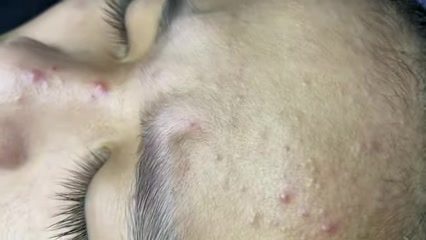Click Button Play To Watch Full Video 👇👇
Nasty and Lengthy Blackhead Removal: The Bent Needle Historical Method
Throughout history, people have sought ways to manage skin imperfections, with blackheads being a particularly persistent nuisance. One of the most notorious methods involves using a bent needle for blackhead removal, a practice that combines elements of desperation, innovation, and risk. This technique not only reflects historical attitudes towards skincare but also highlights the lengths individuals would go to for the sake of beauty.
The Nature of Blackheads
Blackheads are a type of acne that occurs when hair follicles become clogged with oil, dead skin cells, and bacteria. The dark appearance is caused by the oxidation of the material at the surface of the skin. While many modern treatments exist, historical methods were often rudimentary and sometimes perilous. In an era without advanced dermatological practices, individuals turned to DIY solutions, leading to various extraction techniques, including the infamous bent needle method.
The Bent Needle Method
The bent needle technique likely originated from a combination of necessity and ingenuity. The method involves taking a regular sewing needle, sterilizing it, and bending it at a 90-degree angle. This bend allows for precise access to the blackhead while minimizing damage to surrounding skin. Once prepared, the practitioner would gently pierce the skin around the blackhead, carefully working the needle to dislodge the clogged material. The aim was to extract the blackhead without causing excessive trauma to the skin.
While the method could be effective, it was not without its risks. The potential for scarring, infection, and even worsening acne was significant. Without modern sanitation practices, the likelihood of introducing bacteria into the skin was high, leading to complications that could result in more severe skin conditions. Nevertheless, many individuals were willing to take these risks in pursuit of clearer skin.
Cultural Significance
The practice of blackhead removal using a bent needle also carries cultural significance. In various societies, the quest for clear skin has been tied to ideals of beauty and social status. For many, a clear complexion was synonymous with health, vitality, and attractiveness. The act of removing blackheads often became a communal experience, with friends or family members helping one another, thus transforming a solitary task into a bonding ritual.
In some cultures, such practices even had a social dimension, where individuals would share tips and tricks for skincare, creating a network of knowledge passed down through generations. However, this also reinforced societal pressures to maintain a certain appearance, leading some to adopt extreme measures in their quest for beauty.
Modern Reflections
Today, the bent needle method is largely considered outdated and unsafe. Advances in dermatology have led to safer, more effective alternatives for managing blackheads, including professional extractions and chemical treatments. Modern skincare emphasizes gentle care and prevention rather than invasive procedures.
Nonetheless, the bent needle technique serves as a fascinating reminder of humanity’s enduring obsession with beauty. It encapsulates the desperation that often drives individuals to resort to extreme measures for self-improvement. While contemporary society promotes a more balanced view of beauty and self-acceptance, the historical pursuit of flawless skin remains a compelling narrative, illustrating the complexities of human nature and societal expectations.
In summary, the nasty and lengthy process of blackhead removal using a bent needle not only showcases an era of rudimentary skincare practices but also serves as a reflection of cultural values surrounding beauty. As we look back on these methods, we gain insight into the ongoing evolution of skincare and the deep-seated desire for clear skin that transcends time.
